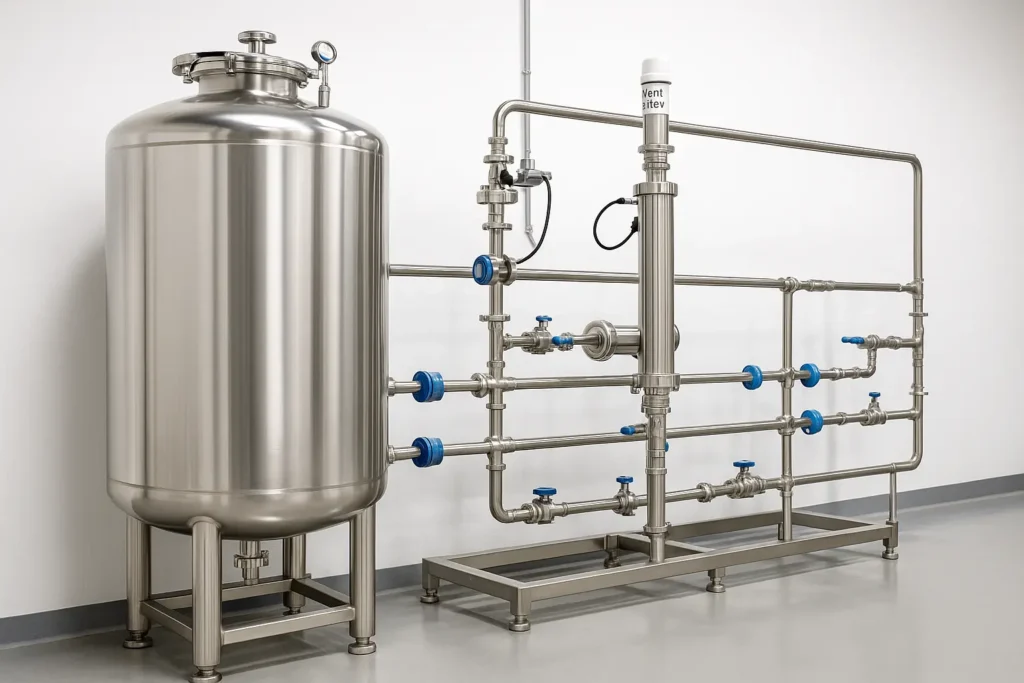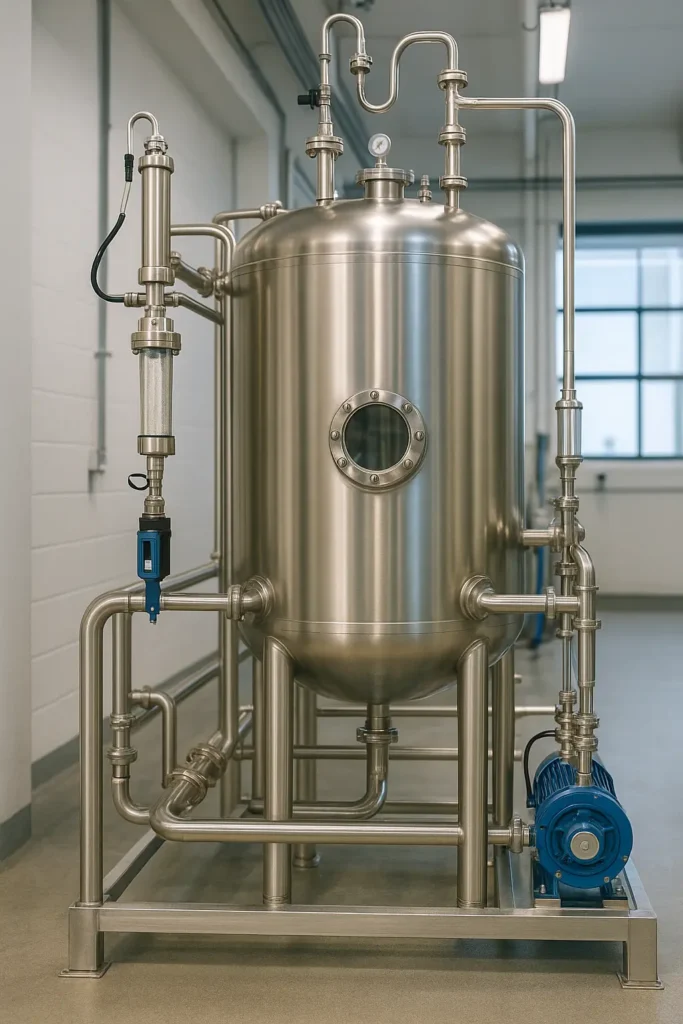Deionized water storage tank and loop design is the backbone of high-purity distribution in B2B facilities. This practical guide shows where the tank fits in the process train, how to size the working volume, set hygienic construction details, pick UV/filtration barriers, control loop velocity, and verify performance against common specs (e.g., ASTM D1193). Use it to scope projects faster and avoid biofilm, TOC creep, CO2 ingress, and dead-leg risks.
Author’s note: This guide reflects Stark Water’s field experience building stainless-steel vessels, sanitary loops and point-of-use polishers for electronics, lab, beverage, and industrial clients.

1) What a DI storage tank & loop is (and where it fits)
A typical high-purity process train places the DI storage tank downstream of RO/double-pass RO (and optional degassing) and upstream of a recirculating distribution loop feeding points of use (POUs) through a UV and a 0.2 µm final filter. The tank buffers demand, stabilizes pressure, and provides a controlled environment for sanitization programs.
- Upstream: RO → (CO2 degassing as required)
- Buffer: Deionized water storage tank (316L sanitary vessel)
- Loop: Recirculation pump → UV (254/185 nm as needed) → 0.2 µm final filter → POUs → return to tank
2) Materials & hygienic construction
This section links hygienic details back to the deionized water storage tank, ensuring the vessel is cleanable, drainable and compliant.
2.1 Tank: 316L stainless steel & finishes
- Material: 316L stainless steel with low ferrite; interior Ra ≤ 0.6–0.8 µm. Electropolish where microbial control is critical.
- Welds & passivation: Ground/crevice-free welds; nitric/citric passivation; validate coverage of spray devices.
- Geometry: Sloped floor/conical or dished heads for full drain; top-mounted sanitary spray ball or rotary jet for CIP.
2.2 Piping & components
- Orbital-welded 316L sanitary tube; clamp connections rated for hot water or ozone sanitization.
- 1–2% slope to drain; eliminate dead legs (T-branch length ≤ 2× diameter).
- Gasket/seat materials with low extractables (EPDM, PTFE, FEP-encapsulated, per OEM).
3) DI water storage tank sizing (stable volume, low water age)
Size the deionized water storage tank for demand smoothing without excessive water age. Typical starting points are below—refine with your peak curve and cleaning strategy.Correctly sizing the deionized water storage tank avoids long water age and stabilizes demand without creating biofilm risk.
3.1 Working volume
- Rule of thumb: 0.5–2.0 hours of average demand. Keep water age < 8–24 h depending on specification and sanitization method.
- Consider: peak shaving, start-up time, emergency hold volume, and OOS corrective rinse volumes.
3.2 Headspace & venting
- Use a 0.2 µm hydrophobic vent filter with heat tracing or heater jacket to prevent condensate backflow.
- Include rupture disk/safety relief, pressure/vacuum protection, and condensate drain.
3.3 Bottom geometry & drainage
- Conical/dished bottoms with full-drain outlet; minimize hold-up after CIP.
- Validate spray pattern for total internal wetting (coverage test during FAT/SAT).
| 매개변수 | 일반 | 참고 |
|---|---|---|
| Working volume | 0.5–2.0 h of avg. demand | Limit water age < 8–24 h depending on spec |
| Headspace vent | 0.2 µm hydrophobic | Heated to prevent condensation; integrity-tested |
| Drainability | Full drain | Sloped floor; no pooling after CIP |
4) DI water loop design — velocity, hydraulics & heat
The loop connected to the deionized water storage tank must maintain scouring velocity while controlling shear and heat rise.
4.1 Loop velocity target
Maintain scouring velocity while controlling shear and heat rise:
- Main loop velocity: 0.9–1.5 m/s (3–5 ft/s) for sanitary tubing.
- Returns/branches: ≥ 0.3–0.6 m/s (1–2 ft/s); avoid stagnant legs.
Quick calc: \( v = \dfrac{Q}{A} \), where \( A = \pi \cdot \dfrac{ID^2}{4} \).
Example: Q = 5 m³/h, DN40 tube (ID≈36 mm). A = 0.00102 m² → v ≈ 1.36 m/s.
4.2 Pump & control
- Sanitary centrifugal pump with VFD; verify NPSH and vibration limits.
- Use throttling valves minimally; prioritize right-sized hydraulics.
4.3 Heat management
- Loop friction and pump work raise temperature; insulate and manage pump duty to stay within spec.
- Consider heat exchanger or periodic cooldown for very tight limits.
5) Final barriers & polishing at points of use
Downstream of the deionized water storage tank, UV and 0.2 μm filtration form the final barrier to meet spec.

5.1 UV selection (254/185 nm)
- UV 254 nm: controls microbial counts; place before final filters.
- UV 185 nm: reduces TOC; confirm material compatibility and ozone by-products management.
5.2 0.2 µm final filters
- Use 0.2 µm or 0.1 µm sterilizing-grade cartridges in sanitary housings; size for flow with end-of-life ΔP.
- Establish integrity testing and documented change-out intervals.
5.3 Sterile air breaks & sampling
- Sterile air gap/venting at storage and POU surge points to prevent back-contamination.
- Install sanitary sampling valves at representative locations.
6) CO2 / silica / boron conditioning (tight specs)
CO2 ingress depresses resistivity and complicates deionized water storage tank monitoring. For tight conductivity/TOC limits, integrate membrane or vacuum degassing interstage; manage temperature and pH to control silica and leverage mixed-bed/EDI polishing where appropriate.
7) Instrumentation, monitoring & release criteria
- Online core: Resistivity@25 °C or conductivity, temperature, flow, pressure, tank level.
- Options: TOC, ORP, UV intensity, microbial counters (per validation plan).
- Release: Define acceptance ranges (e.g., resistivity, TOC, CFU). Trend and alarm on drift, not just limits.
8) Cleaning & sanitization (CIP/SIP)
8.1 Hot water / ozone / chemical CIP
- Hot water: 70–85 °C loops for defined time; verify valves/gaskets rating.
- Ozone: Excellent for cold sanitization; confirm seal compatibility and destruct UV at release.
- Chemical CIP: Peroxide/peracetic or suitable disinfectants; controlled rinse to neutral.
8.2 Compatibility & change control
- Keep a materials register (elastomers, plastics) with compatibility notes for your chosen sanitant.
- Document procedures, lot traceability, and verification data in IQ/OQ and PM records.
9) Documentation & compliance
- Baseline to ASTM D1193 classes as applicable.
- Leverage WQA and ISPE guidance for design qualification—see WQA resources.
- Maintain P&IDs, weld logs, slope maps, spray-device coverage tests, and sanitization validation reports.
10) Quick sizing worksheet
Use this one-page worksheet to size your DI water storage tank and loop. Replace the gray numbers with your site data.
- Working volume: Vwork = Average flow (m³/h) × Buffer time (h). Start at 0.5–2.0 h.
- Loop velocity: Pick tube size to hit 0.9–1.5 m/s at nominal flow.
- Vent filter: 0.2 µm hydrophobic; heat or insulate to avoid condensate.
- Final filter: Size for end-of-life ΔP at peak flow; plan integrity tests.
11) Common mistakes & fast fixes
- Dead legs and reverse slopes → redesign tees, shorten drops, enforce 1–2% slope.
- CO2 lowering resistivity → fix air leaks, add degassing, heat/insulate vents.
- TOC creep → check gasket extracts, add UV185, refresh sanitization cadence.
- Stagnant headspace → verify vent heating and periodic pulsed aeration with sterile air.
12) Next steps (RFQ & internal links)
Share your RO permeate analysis and demand curve—we’ll size the deionized water storage tank, loop hydraulics and final barriers, and propose a hygienic stainless-steel package.
Stainless-steel products - RO membrane & skid basics - EDI vs. mixed-bed polish
13) FAQs
What tank material is best for a DI water storage tank?
316L stainless steel with sanitary construction (low Ra, crevice-free welds) is preferred for durability, low extractables and validated cleaning. High-end plastics may be used in non-sanitary utilities but are more difficult to sanitize and validate.What loop velocity should I target?
For sanitary tubing, 0.9–1.5 m/s in the main loop and ≥0.3–0.6 m/s in returns keeps biofilm in check without excessive heating or shear. Confirm by calculation and site testing.Do I need UV or ozone in a DI loop?
Most high-purity systems use UV 254 nm for microbial control and optionally UV 185 nm for TOC reduction. Ozone is powerful for cold sanitization but requires compatible materials and ozone destruct before release.How often should I change the 0.2 µm vent filter?
Follow OEM guidance and your validation plan—typical programs replace at defined pressure drop, integrity failure, or time-in-service (e.g., quarterly) and after thermal excursions.
Reviewed by the Stark Water process engineering team. Last reviewed: .

